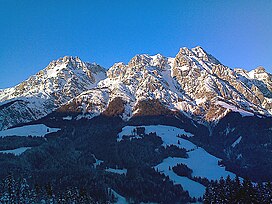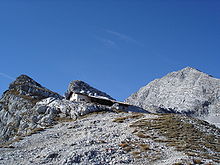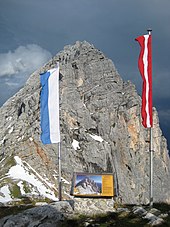
The Saalach is a 105-kilometre-long (65 mi) river in Austria and Germany, and a left tributary of the Salzach.

The Kitzbühel Alps are a mountain range of the Central Eastern Alps surrounding the town of Kitzbühel in Tyrol, Austria. Geologically they are part of the western slate zone.
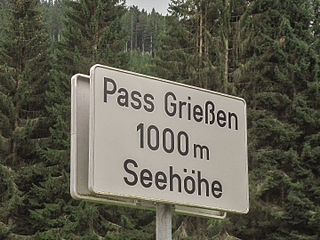
Grießen Pass is a high mountain pass in the Austrian Alps between the federal states of Salzburg and Tyrol.

Saalfelden am Steinernen Meer is a town in the district of Zell am See in the Austrian state of Salzburg. With approximately 16,000 inhabitants, Saalfelden is the district's largest town and the third of the federal state after Salzburg and Hallein.
The Leoganger Ache is a river of Salzburg, Austria, a left tributary of the Saalach.
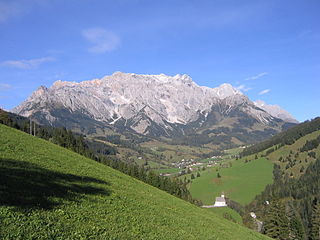
The Berchtesgaden Alps are a mountain range of the Northern Limestone Alps, named after the market town of Berchtesgaden located in the centre. The central part belongs to the Berchtesgadener Land district of southeastern Bavaria, Germany, while the adjacent area in the north, east and south is part of the Austrian state of Salzburg.
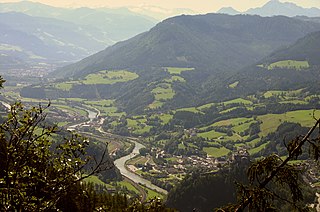
The Salzburg Slate Alps are a mountain range of the Eastern Alps, in the Austrian state of Salzburg. Situated within the greywacke zone, they could be regarded either as part of the Northern Limestone Alps or of the Central Eastern Alps.

The Lofer Mountains or Loferer Mountains are a mountain range in the Northern Limestone Alps in the Eastern Alps of central Europe. They are located in Austria in the federal states of Tyrol and Salzburg. The Lofers are separated from the Leogang Mountains to the southeast by a 1,202 m-high saddle known as the Römersattel.

The Salzachgeier is a rugged peak on the edge of the Kitzbühel Alps on the border of the Austrian states of Salzburg and Tyrol. In the cirques and high alpine meadows (Hochalmen) of its eastern slopes and the two neighbouring peaks of Fünfmandling (2,401 m) and Schwebenkopf (2,354 m) are the headstreams of the Salzach, the largest river north of the Salzburg Central Alps.
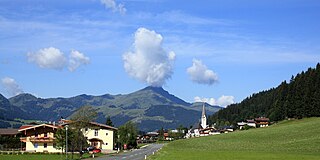
The Pillersee Valley is a valley in the district of Kitzbühel in the Austrian state of Tyrol, on the border with Salzburg state.
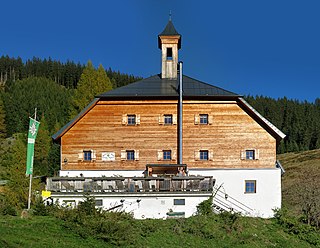
The Bochumer Hut, also called Kelchalm or Kelchalpe, is an Alpine club hut in the Kitzbühel Alps in the Austrian state of Tyrol. It is owned by the Bochum Section of the German Alpine Club. Today the hut is a popular destination for hikers and also has overnight accommodation.

The Wildseeloderhaus is an Alpine hut owned by the Austrian Alpine Club (OeAV) that lies below the Wildseeloder mountain in the Kitzbühel Alps in Austria.
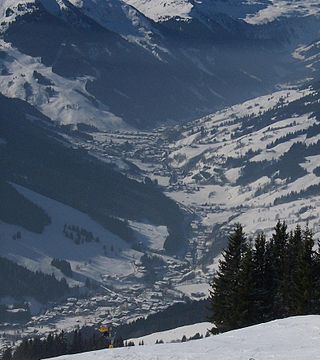
The Glemmtal in the Austrian state of Salzburg is the valley of the roughly 30 km long upper reaches of the River Saalach. It belongs to the northern Pinzgau region and separates the Kitzbühel Alps in an east-west direction. Its main settlement is the village of Saalbach in Zell am See district.
The Saalach Valley Ridgeway is a roughly five-hour long ridgeway trail in the Salzburg part of the Kitzbühel Alps between Leogang and Saalfelden.
The Pinzgau Ridgeway is a roughly 25 kilometre long ridgeway in the Kitzbühel Alps in the Austrian federal state of Salzburg.
The Hochkönig Road, – the B 164 – is a state road (Landesstraße) in Austria. It has a length of 75 kilometres (47 mi). Beginning in Bischofshofen in the Salzach valley, it runs initially between the Hochkönig and Dienten Mountains along the Dienten Saddle and on into the valley of the Saalach to Saalfelden am Steinernen Meer. On the far side of the Saalach the road runs into the Leoganger Tal between the Leoganger Steinberge and the Loferer Steinberge to the north and the Kitzbühel Alps to the south via Leogang up to the Grießen Pass, and via Fieberbrunn downhill again into the valley of the Kitzbühler Ache to St. Johann in Tirol. On the last section the road runs parallel to the Salzburg-Tyrol Railway.
The Saalach Valley is the name of the middle and upper reaches of the Saalach, a mountain river in the Austrian state of Salzburg and the southern part of the German state of Bavaria.

The Birnhorn is an isolated mountain in the Leoganger Steinberge, Northern Limestone Alps, Austria.

The Goldberg Group is a sub-group of the Hohe Tauern mountain range within the Central Eastern Alps. It is located in Austria, in the states of Salzburg and Carinthia. Its highest peak is the Hocharn, 3,254 m (AA). Other well known summits are the Hoher Sonnblick, with its observatory at 3,106 m above sea level (AA), and the Schareck at 3,123 m above sea level (AA)

The Villgraten Mountains or Deferegg Alps, also called the Defreggen Mountains are a subgroup of the Austrian Central Alps within the Eastern Alps of Europe. Together with the Ankogel Group, the Goldberg Group, the Glockner Group, the Schober Group, the Kreuzeck Group, the Granatspitze Group, the Venediger Group and the Rieserferner Group, the Villgraten Mountains are part of the major mountain range, the High Tauern. Their highest summit is the Weiße Spitze with a height of 2,962 m above sea level (AA).
